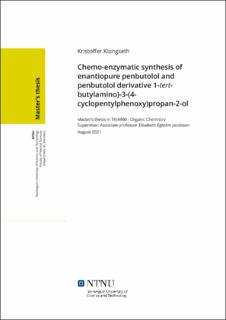| dc.contributor.advisor | Jacobsen, Elisabeth Egholm | |
| dc.contributor.author | Klungseth, Kristoffer | |
| dc.date.accessioned | 2021-09-28T18:34:07Z | |
| dc.date.available | 2021-09-28T18:34:07Z | |
| dc.date.issued | 2021 | |
| dc.identifier | no.ntnu:inspera:77798797:20637109 | |
| dc.identifier.uri | https://hdl.handle.net/11250/2785509 | |
| dc.description.abstract | I denne oppgaven ble to enantiomert rene stoffer syntetisert ved å bruke Candida antarctica lipase B (CALB) som enantioselektiv biokatalysator i kinetisk resolusjon. (S)-1-(tert-butylamin)-3-(4-syklopentylfenoksy)propan-2-ol ble syntetisert i 96% enantiomerisk eksess og 29% utbytte. Dette ble utført ved CALB-katalysert kinetisk resolusjon av 1-klor-3-(4-syklopentylphenoksy)propan-2-ol, etterfulgt av aminering med tert-butylamin. Denne syntesen ble brukt som en modell for syntese av beta-blokkeren penbutolol.
1-Klor-3-(2-syklopentylfenoxy)propan-2-ol, en byggestein for penbutolol, ble syntetisert i 58\% utbytte. Dette ble utført ved en substitusjonsreaksjon av 2-syklopentylfenol med epiklorhydrin, etterfulgt av epoksid-ringåpning med litiumklorid og eddiksyre. Disse reaksjonene har blitt undersøkt, og resultatene er diskutert i denne oppgaven.
(S)-Penbutolol ble også syntetisert i 96% enantiomerisk eksess. Dette ble utført ved CALB-katalysert kinetisk resolusjon av byggesteinen 1-klor-3-(2-syklopentylphenoksy)propan-2-ol, etterfulgt av aminering med tert-butylamin. Dette ga 68% renhet, men det er diskutert hvordan det kan rengjøres bedre. Enantioselektiviteten og den katalytiske aktiviteten til CALB mot forskjellige substrater er også undersøkt og diskutert. | |
| dc.description.abstract | In this thesis, two enantiopure compounds were synthesized using Candida antarctica lipase B (CALB) as enantioselective biocatalyst in kinetic resolution. (S)-1-(tert-butylamino)-3-(4-cyclo-pentylphenoxy)propan-2-ol was synthesized in 96% enantiomeric excess and 29% yield. This was done by CALB-catalyzed kinetic resolution of 1-chloro-3-(4-cyclopentylphenoxy)propan-2-ol, followed by amination with tert-butylamine. This synthesis was used as a model for the synthesis of the beta-blocker penbutolol.
1-Chloro-3-(2-cyclopentylphenoxy)propan-2-ol, a building block for penbutolol, was synthesized in 58\% yield. This was done by a substitution reaction of 2-cyclopentyl phenol with epichlorohydrin, followed by epoxide ring opening with lithium chloride and acetic acid. These reactions have been investigated, and the results are discussed in this thesis.
(S)-Penbutolol was also synthesized in 96% enantiomeric excess. This was done by CALB-catalyzed kinetic resolution of the building block 1-Chloro-3-(2-cyclopentylphenoxy)propan-2-ol, followed by amination with tert-butylamine. This resulted in 68% purity, but suggestions are made in this thesis of how to purify it further. The enantioselectivity and catalytic ability of the biocatalyst CALB towards the different substrates are also investigated and discussed. | |
| dc.language | eng | |
| dc.publisher | NTNU | |
| dc.title | Chemo-enzymatic synthesis of enantiopure penbutolol and penbutolol derivative 1-(tert-butylamino)-3-(4-cyclopentylphenoxy)propan-2-ol | |
| dc.type | Master thesis | |
